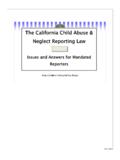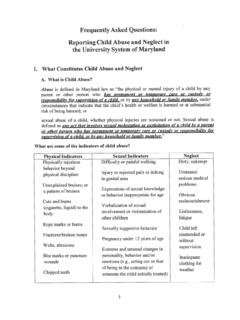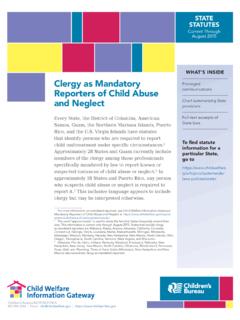Transcription of What is Child Abuse? - thecapcenter.org
1 1 What is Child abuse ? Child abuse impacts all levels of our society and has long-term effects that threaten the health and well-being of our community. To Report abuse You may call Sacramento County Child Protective Services Emergency Hotline: (916) 875-5437 (916) 875-KIDS The Information and Referral line provides resources available for the prevention, intervention, and treatment of Child abuse and neglect: (916) 244-1900. What is Child abuse ? The California Definition A Child is a person who has not attained the age of 18. Any act of omission or commission that endangers a Child s physical or emotional health and development. What is Child abuse ?
2 The Federal Definition A Child is a person who has not attained the age of 18. At a minimum, any recent act or failure to act on the part of a parent or caretaker which results in death, serious physical or emotional harm, sexual abuse or exploitation. At a minimum, an act or failure to act which presents an imminent risk of serious harm? To many, Child abuse is narrowly defined as having only physical implication. In reality categories of Child abuse includes: Physical abuse ; unlawful corporal punishment or injury. General and severe neglect. Emotional abuse Sexual abuse ; sexual assault; exploitation. Willful cruelty or unjustifiable punishment; emotional maltreatment.
3 Child abuse may involve multiple categories. They include both acts and omissions. Competent interventions must consider evaluating multiple categories of abuse . The act of inflicting injury or the failure to act so that injury results, rather than the degree of injury, is the basis for making the decision to intervene. Physical and Behavioral Indications that Child abuse May be Occurring 2 These indicators, or red flags are the things you might see, which might give you the suspicion that Child abuse has occurred or is occurring. Below, you will be given lists of typical indicators for each type of abuse . However, here are no hard and fast rules on what indicator would be seen with a particular type of abuse .
4 For example, bed-wetting is listed under sexual abuse , but it may also be found in instances of physical abuse . These indicators alone may not warrant a report, however, if in sufficient number and strength may indicate abuse . Physical abuse California Penal Code Section Physical abuse is defined as physical injury inflicted on a Child by other than accidental means to include but not limited to the following: Willful cruelty or unjustifiable punishment of a Child where a person willfully causes or permits any Child to suffer, or inflicts thereon unjustifiable physical pain or mental suffering. When a person willfully causes or permits the person or health of the Child to be placed in a situation such that this or her person or health is endangered.
5 Unlawful cruel or inhumane corporal punishment resulting in a traumatic condition. Physical abuse Federal Guidelines Physical injury as a result of punching, beating, kicking, biting, burning, shaking or otherwise harming a Child . The parent or caretaker may not have intended to hurt the Child ; rather the injury may have resulted from over-discipline or physical punishment. The Four Distinct Characteristics of Non-Accidental Injuries Location of the injury Pattern of the injury Correlation of the story to the injury Degree or extent of the injury Location of the Injury Injury from abuse is most often located on the following areas: Head and neck area (This area is vulnerable to injury because of a Child s small may the closest body part to an adult s hand or fist.)
6 Also, it is often targeted as it is where the crying, back talk, sass, bad language, etc. is emanating from. The area of the head 3 covered by hair may be targeted as the hair covers any bruising or lumps). Hands are targeted as they are actively exploring or getting into things Upper arms Front and backs of thighs Genital area Stomach Back Buttock Normal childhood injuries are typically located on areas where the skin is close to the bone, such as: shins knees hips elbows lower arms hands Pattern of the Injury Injury or bruises in a pattern which reflects the object used - a belt buckle, a handprint (the hand is the most common object used), knuckles, bottom of an iron, etc.
7 Frequency of and/or recurrent injuries to the same site - Child abusers often injure their victim in the same manner or use the same implement Clustered bruises Human bite marks - this might be found in sexual abuse cases as well as physical abuse . Two black eyes - it is very unusual to have two black eyes unless you have been in a car accident, or have broken your nose Correlation of the Story The parent and/or Child tell conflicting or confusing stories on how the injury occurred Treatment is delayed for fear of being caught Hospital or Doctor hopping to avoid suspicion because of frequent visits County hopping to avoid CPS intervention School hopping to avoid suspicion from school personnel Poisoning, especially in children under 6 months and over 6 years of age - children over six generally know better and children under 6 months are not mobile.
8 Conditions That Could Be Mistaken for Child abuse Children with hemophilia, low blood platelet count or Leukemia tend to bruise easily. 4 A birth mark (sometimes call Mongolian Spot) is a deep purple/bluish/grayish birthmark which looks like a bruise. They can be anywhere on the body, but typically are on the buttocks and lower back. Mongolian spots are commonly found in African Americans, Asians and Hispanics. Impetigo is a skin condition with sores that look like crusty, healing burns. General Indicators of Physical abuse Indication of abuse often remains on the body If a Child discloses that abuse is/has occurred, it should be taken seriously Any injury which is unusual for Child s age or development Shaken Baby Syndrome Retinal Hemorrhage Unexplained vision or hearing problems Lacerations/abrasions which are not regular childhood-type injuries Skeletal injuries and/or multiple fractures on different parts of the body Internal or abdominal injuries Absence of hair due to pulling Injuries from pulling or twisting Injuries in various stages of healing Moves stiffly or gingerly Bruises Bruises in various stages of healing Bruises that regularly appear after absences, weekends or vacations.
9 Bruises of any kind on an infant, especially on the face and buttocks Clustered bruises Bruises reflecting the shape of the object used, such as the hand, belt buckle, Burns Burns in unusual places such as the soles of feet, palms of hands, buttocks, etc. Perfectly round burns the size of a cigarette tip or car lighter. Burns reflecting the pattern of the electrical appliance used, such as BBQ starter. Rope burns on limbs, neck or torso Scalding burns are the most common. Deliberate immersion burns will leave distinct waterlines such as: Burns resembling sock-like or mitten-like markings on the hands or feet Doughnut burn pattern on the buttocks - the Child was pressed against in the bottom of the tub so forcibly, water doesn t come in contact with the center part of the buttock A Child accidentally falling into scalding water would have splash or irregular shaped burns, 5 not distinct lines No burns in areas where the Child has flexed in reaction to what was happening, , arms tightened and folded against body, folds in the stomach, thighs against abdomen.
10 Scalding burns on the back - Child was probably trying to run away from perpetrator. Behavioral Indicators of Physical abuse Child is uneasy or frightened when discussing injury Parent or Child is overly passive or aggressive Child overly afraid or protective of parent Lags in development Bullies other children to get even with the world Constantly alert to danger Runs away Head banging Extreme or inappropriate reaction to pain Clinging Destructive behavior toward self and others Inappropriate dress to hide injury Chronic absence or tardiness in school School difficulties Arriving early and leaving late from school to avoid going home Wary of physical contact Parent may send Child to






